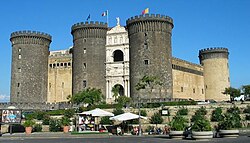Castel Nuovo

The Castel Nuovo (Italian: 'New Castle'), often also called Maschio Angioino , is a castle in Naples , Italy . It is one of the most famous buildings in the city. The castle has been rebuilt and renovated several times since construction began in 1279. Under different kings it served mostly in a double function as a fortress and residence .
history
Before Charles I of Anjou ascended the throne in 1266, Palermo was the capital of the Kingdom of Naples . Although the Castel Capuano had previously been a royal residence in Naples, after the capital was moved to Naples, Charles gave instructions to build a new castle near the sea to accommodate his court. The work began in 1279 under the supervision of the priest Pierre de Chaule as an architect and lasted a total of three years.
During the Sicilian Vespers , the castle remained uninhabited until 1285, the year in which Charles I died and was succeeded by his son Charles II . Under him and his successor Robert the Wise , who reigned from 1309, the fortress was expanded and rebuilt several times and more and more became the nucleus of the urban development of Naples.
From 1329 to 1331, during his stay in the city , the painter Giotto decorated the palace chapel with frescoes, only fragments of which have survived.
In 1347 the Castel Nuovo was badly damaged by the army of Louis I of Hungary and had to be extensively restored after the return of Queen Joan I of Naples .
Under the later rule of the Aragonese , which began with Alfonso V of Aragon in 1442, the fortress was extensively redesigned, among other things to withstand the new weapons technology challenges. The triumphal arch at the main gate, designed by Francesco Laurana , celebrates Alfons' arrival in Naples. The construction work on the triumphal arch began at the latest in 1453, illustrations from 1464 show it already completed.
The Sala dei Baroni, one of the largest secular rooms of its time, was the seat of the Campanian regional parliament until 2006. Today the Museo Civico (Museum of the City of Naples) is housed in the west wing of the castle.
See also
literature
- George L. Hersey : The Aragonese Arch at Naples, 1443-1475 . Yale University Press, New Haven 1973, ISBN 0-300-01611-5 .
- Andreas Beyer : Parthenope. Naples and the South of the Renaissance. Deutscher Kunstverlag, Berlin / Munich 2000, ISBN 3-422-06291-2 .
Web links
- Official website of the Museo Civico , (Italian / English)
- Information on the castle and museum at Museo Italia , (multilingual)
Individual evidence
- ^ Loredana Gazzara: Napoli . Mondadori-Electa, Milan, 2007, p. 124.
Coordinates: 40 ° 50 ′ 17.88 " N , 14 ° 15 ′ 11.52" E
